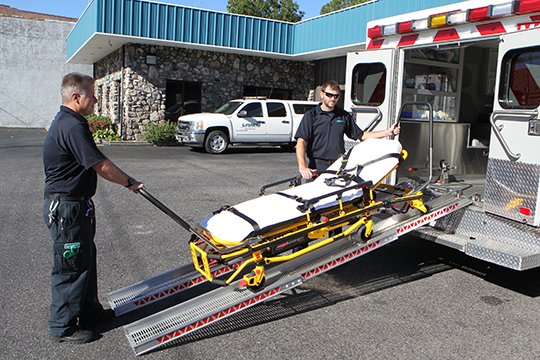LifeNet installed a new bariatric cot and loading system in one of its ambulances earlier this month that is specifically designed to handle large patients.
While it has not been used for a patient as yet, Jason Gartner, LifeNet's general manager, said Thursday that the service transported 16 patients in August alone that were heavier than 350 pounds, so it's just a matter of time until it's needed.
"That's not to say that it will be used in every instance of a patient that is larger than 350 pounds," he said. "There will be operational and clinical considerations to consider on a case-by-case basis."
This system is safer for both the patients and the EMS personnel, a news release said. According to a report produced by Trust for America's Health and the Robert Wood Johnson Foundation, Arkansas is now ranked sixth in the nation for adult obesity.
Gartner said it is the girth, and not just the weight, of the patients that prompted LifeNet to determine it needed a specialized cot and loading system.
"Honestly, the industry has been adopting bariatric-capable equipment for a couple of years now. I think it's all related to the fact that we are encountering larger patients more and more frequently and the technology is finally being developed to assist in the safe and effective transport on these cases," he said.
The system was purchased from Stryker Medical and includes a cot that is wider than normal, a winch system, and ramps that secure to the floor of the ambulance. "Previously some patients were not as comfortable on traditional cots. And, because the patient's width is wider than the width of the cot, they also expressed anxiety about the possibility of the cot tipping," Gartner said in the release.
"The new bariatric cot is wider than traditional cots and is designed to travel at a lower height which increases both comfort and stability."
The new cot can carry a maximum load of 1,600 pounds, which is more than twice what LifeNet's traditional cots carry, and are also 6 inches wider. The system makes moving and transporting larger patients easier and safer.
Gartner said the equipment alone costs $15,062, not including retrofitting the system into an existing ambulance, but he stressed LifeNet considers it a necessary and cost-efficient purchase.
"It may seem like a lot of money. But from both the patient's, and employee's points of view, it is the right choice. If we prevent one injury, whether it be an employee or a patient, the system has done its job and likely paid for itself."
LifeNet has begun the process of training its staff on the operation of the system. Because there are few bariatric equipped ambulances in the state, Gartner said he believes once the word gets out about this resource they might be requested to provide aid to the surrounding geographical area.
"Certainly all the counties surrounding Garland County. We already provide mutual aid to all the EMS agencies that we have a shared border with," he said, noting, "Helping your neighbor out in an emergency is a normal part of our work."
He said going beyond the surrounding counties would be atypical, but "in the case of a bariatric patient that needed transported, especially if it is a scheduled type of movement and not an emergency, I think we would consider going further."
He added, "If it was an emergency situation I'd be concerned that the response time for us to get to a location two counties away would be considerable." He noted the only other bariatric capable ambulance he was aware of in central Arkansas was at MEMS in Little Rock.
"So, with so few resources available, we would make every attempt to provide our resources if needed by other EMS agencies without unduly decreasing our ability to service our primary response area."
Local on 09/30/2016